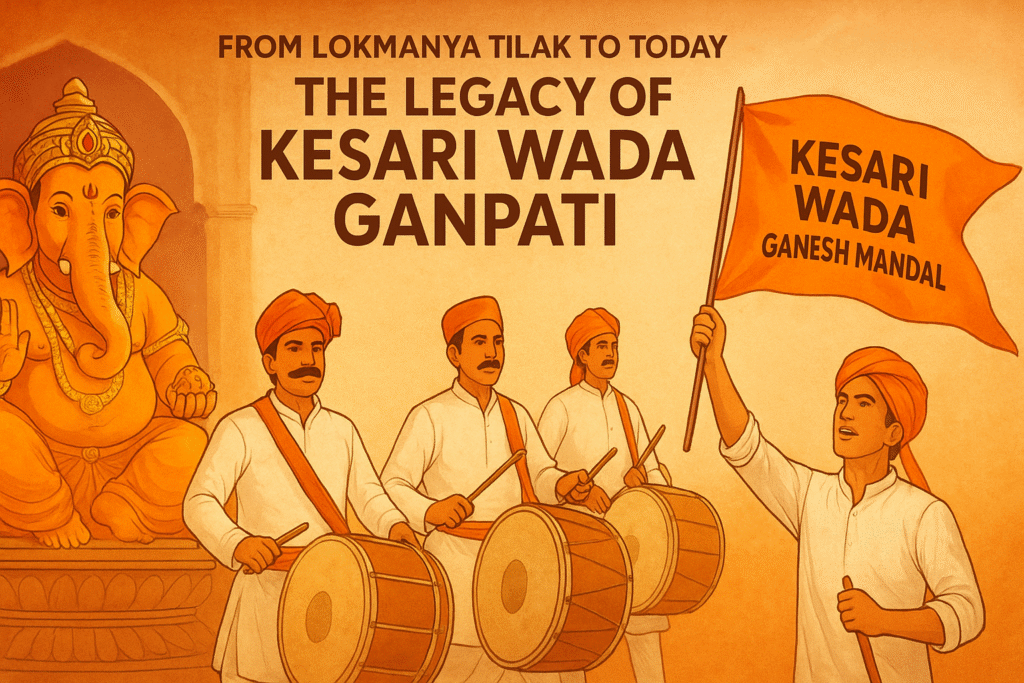When it comes to Ganesh Chaturthi in Pune, one name that shines with immense pride and history is the Kesari Wada Ganpati. This is not just a place of devotion; it is a living reminder of India’s freedom struggle, started under the vision of Lokmanya Bal Gangadhar Tilak.
The Birth of Public Ganeshotsav
In the late 19th century, Ganeshotsav in Pune was a private affair celebrated in households. It was Lokmanya Tilak who transformed the festival into a public celebration at Kesari Wada in 1893. His goal was clear – to unite people under one cultural and spiritual umbrella while sowing the seeds of India’s independence movement.
By organizing the first public Ganesh festival at Kesari Wada, Tilak gave Indians not only a religious platform but also a strong sense of social and political unity.
Historical Significance of Kesari Wada
The Kesari Wada in Pune was originally the residence of Tilak and also the office of his famous newspaper Kesari. This place became a hub of freedom activities, intellectual discussions, and public gatherings. The Kesari Wada Ganpati Mandal thus became a symbol of both devotion and patriotism.
Every year, the idol of Lord Ganesha at Kesari Wada attracts thousands of devotees who come not just for darshan but also to connect with the rich heritage of Pune.
Kesari Wada Ganpati Today
Even today, the Kesari Wada Ganeshotsav holds a special place among the famous Ganpati Mandals in Pune. Unlike the grand decorative pandals across the city, Kesari Wada Ganpati maintains a balance of simplicity, cultural programs, and historical exhibitions.
- Cultural Events: Programs on literature, music, and social awareness.
- Historical Exhibits: Showcasing Tilak’s contribution to Indian freedom struggle.
- Social Initiatives: Blood donation camps, educational drives, and awareness campaigns.
This unique blend makes the Kesari Wada Ganpati Mandal not just a festival site but also a platform for social change.
Why Kesari Wada Ganpati is Special
- It is the first public Ganesh Mandal in India, started by Lokmanya Tilak.
- The Kesari Wada premises connect spirituality with India’s freedom movement.
- It preserves the heritage of Pune while inspiring future generations.
FAQs about Kesari Wada Ganpati
1. Who started Kesari Wada Ganpati?
👉 The Kesari Wada Ganpati Mandal was started by Lokmanya Bal Gangadhar Tilak in 1893.
2. Why is Kesari Wada Ganpati famous?
👉 It is famous as the first public Ganesh festival in India and for its strong connection with the Indian freedom struggle.
3. Where is Kesari Wada located?
👉 Kesari Wada is located in Narayan Peth, Pune, Maharashtra. It was once the residence of Tilak and the office of the Kesari newspaper.
4. What makes Kesari Wada Ganeshotsav different from other Ganpati Mandals?
👉 Unlike other decorative mandals, Kesari Wada Ganpati focuses on cultural programs, historical exhibitions, and social awareness initiatives.
5. Can visitors see historical exhibits at Kesari Wada during Ganeshotsav?
👉 Yes, visitors can see exhibitions about Lokmanya Tilak, the Kesari newspaper, and India’s freedom struggle during the festival.
Conclusion
The legacy of Kesari Wada Ganpati continues from the time of Lokmanya Tilak to today, standing as a symbol of devotion, unity, and nationalism. Visiting Kesari Wada Ganeshotsav is not just about seeking blessings; it is about experiencing the spirit of India’s cultural and political awakening.
So, if you are in Pune during Ganesh Chaturthi, make sure to witness the grandeur and history of Kesari Wada Ganpati – a true pride of Maharashtra.



